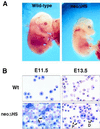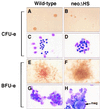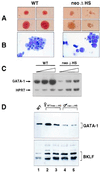A "knockdown" mutation created by cis-element gene targeting reveals the dependence of erythroid cell maturation on the level of transcription factor GATA-1
- PMID: 9192642
- PMCID: PMC21235
- DOI: 10.1073/pnas.94.13.6781
A "knockdown" mutation created by cis-element gene targeting reveals the dependence of erythroid cell maturation on the level of transcription factor GATA-1
Abstract
The hematopoietic-restricted transcription factor GATA-1 is required for both mammalian erythroid cell and megakaryocyte differentiation. To define the mechanisms governing its transcriptional regulation, we replaced upstream sequences including a DNase I hypersensitive (HS) region with a neomycin-resistance cassette by homologous recombination in mouse embryonic stem cells and generated mice either harboring this mutation (neoDeltaHS) or lacking the selection cassette (DeltaneoDeltaHS). Studies of the consequences of these targeted mutations provide novel insights into GATA-1 function in erythroid cells. First, the neoDeltaHS mutation leads to a marked impairment in the rate or efficiency of erythroid cell maturation due to a modest (4- to 5-fold) decrease in GATA-1 expression. Hence, erythroid differentiation is dose-dependent with respect to GATA-1. Second, since expression of GATA-1 from the DeltaneoDeltaHS allele in erythroid cells is largely restored, transcription interference imposed by the introduced cassette must account for the "knockdown" effect of the mutation. Finally, despite the potency of the upstream sequences in conferring high-level, developmentally appropriate expression of transgenes in mice, other cis-regulatory elements within the GATA-1 compensate for its absence in erythroid cells. Our work illustrates the usefulness of targeted mutations to create knockdown mutations that may uncover important quantitative contributions of gene function not revealed by conventional knockouts.
Figures




References
Publication types
MeSH terms
Substances
LinkOut - more resources
Full Text Sources
Other Literature Sources
Molecular Biology Databases

